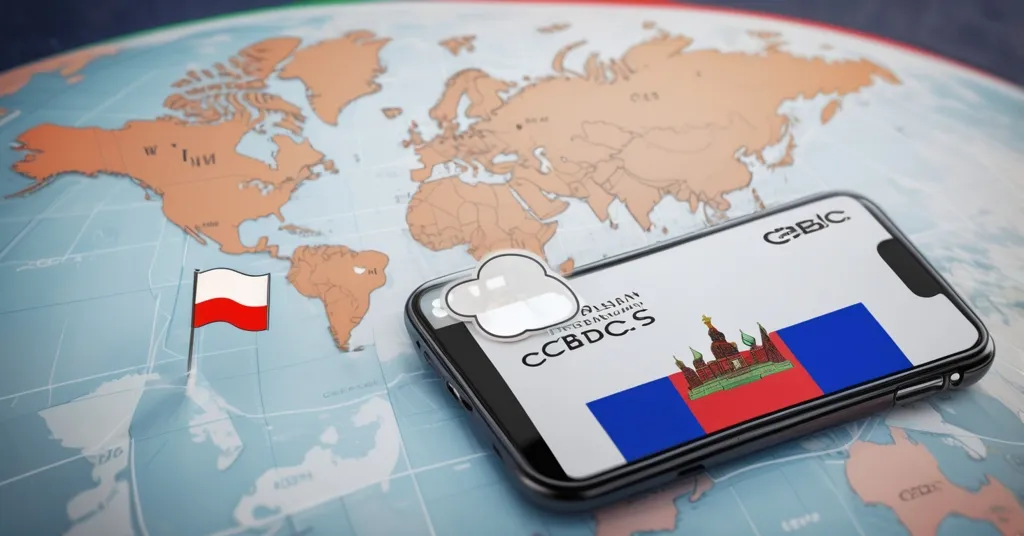Russia’s CBR Tests Digital Ruble with Smart Contracts in Tatarstan

Central Bank of Russia Advances Digital Ruble Testing in Tatarstan
The Central Bank of Russia (CBR) is taking bold steps into the future of currency with a pilot program in Tatarstan, testing the digital ruble’s smart contract capabilities. This initiative aligns with a global surge in Central Bank Digital Currency (CBDC) exploration, with 134 countries diving into the digital money pool.
- CBR pilots digital ruble in Tatarstan with smart contracts.
- Pilot to conclude in Q3 2025, broader rollout delayed.
- 134 countries globally exploring CBDCs.
In Tatarstan, the CBR isn’t just dipping its toes into digital currency but is swimming in the deep end with smart contracts. These are self-executing contracts with terms written into code, enabling automatic transactions based on specific conditions. The digital ruble is being tested for conditional spending, meaning the money can be programmed to be used only for certain things—like ensuring welfare payments are spent on food or medicine. The Tatarstan Ministry of Finance has set up a working group to oversee this experiment, which is slated to end in the third quarter of 2025. While the digital ruble law kicked in back in August 2023, and initial testing began on August 15, the broader rollout planned for July 1, 2025, has hit the pause button. CBR head Elvira Nabiullina insists on thorough testing and consultations with banks to ensure the model is economically viable for clients.
“The large-scale rollout will only take place after thorough testing and consultations with banks about the most economically viable model for clients.”
This cautious approach mirrors the global landscape where CBDCs are being explored with varying degrees of urgency and caution. Countries like China, Korea, Papua New Guinea, the United Kingdom, and the European Union are all at different stages of testing their digital currencies, while the Bahamas, Jamaica, and Nigeria have already launched theirs. It’s a digital currency race, and Russia’s digital ruble aims to be more than just a spectator.
The focus on smart contracts for conditional spending is a nod to the innovative potential of blockchain technology. However, it’s not all sunshine and roses. Delaying the rollout past July 1, 2025, shows the complexities and challenges central banks face in rolling out national digital currencies. It’s a delicate dance between pushing the envelope of innovation and maintaining the stability and functionality of the system.
As we watch Russia’s moves, it’s clear the digital ruble is a piece of a larger puzzle. With 134 countries exploring CBDCs, we’re seeing a potential shift in the global financial landscape. Yet, the delay in Russia’s rollout also serves as a reminder of the hurdles that come with pioneering new monetary systems. From the bustling streets of Tatarstan to the halls of central banks worldwide, the digital currency revolution is underway, but it’s not without its twists and turns.
But let’s not forget the elephant in the room: how do CBDCs stack up against decentralized cryptocurrencies like Bitcoin? While CBDCs offer programmability and governmental control, they lack the privacy and decentralization that Bitcoin maximalists cherish. Bitcoin, with its fixed supply and decentralized nature, remains a beacon of financial freedom and disruption, challenging the very concept of centralized digital currencies. Yet, CBDCs and Bitcoin aren’t necessarily at odds; they represent different facets of the financial revolution, each serving unique purposes in the broader ecosystem. For a deeper dive into this comparison, check out this analysis.
Here are some key questions and takeaways to consider:
- What is the focus of the CBR’s pilot program in Tatarstan?
The focus is on testing smart contracts for conditional spending with the digital ruble, allowing for more targeted financial transactions. - When is the pilot program expected to conclude?
The pilot program is set to wrap up in the third quarter of 2025, providing ample time for detailed testing. - Why has the broader rollout of the digital ruble been delayed?
The delay is due to the need for further testing and consultations with banks to ensure the digital ruble’s economic viability for clients. - How many countries are currently exploring CBDCs?
Globally, 134 countries are delving into the possibilities of national CBDCs, reflecting a widespread interest in digital currencies. - Which countries have already launched their CBDCs?
The Bahamas, Jamaica, and Nigeria have taken the leap, launching their CBDCs and setting precedents in the digital currency space.
While the CBR’s initiative in Tatarstan is a step towards a digital future, it’s also a reminder that the road to widespread adoption of CBDCs is paved with both promise and challenges. As we continue to monitor these developments, one thing is clear: the future of money is digital, but getting there will require patience, innovation, and a keen eye on the global financial dynamics at play. And for those of us who believe in decentralization and effective accelerationism, the journey is just as thrilling as the destination.



